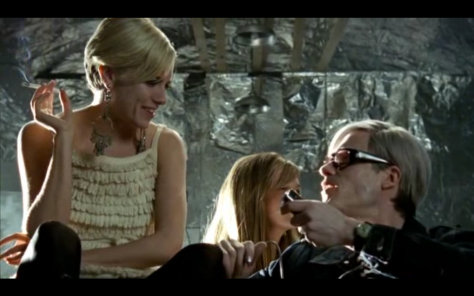By Dennis Hartley
(Originally posted on Digby’s Hullabaloo on October 31, 2009)

Bill and Andy’s excellent adventure.
Since 1883, the Hotel Chelsea in New York City has been the center of the universe for bohemian culture. It has been the hostelry of choice for the holiest of hipster saints over the years, housing just about anybody who was anybody in the upper echelons of poets, writers, playwrights, artists, actors, directors, musicians, and free thinkers over the past century.
Some checked in whenever they were in town, and some lived as residents for years on end. Some checked out forever within its walls over the years (from Dylan Thomas to Sid Vicious’ ill-fated girlfriend, Nancy Spungen). Of course, not every single resident was a luminary, but chances are they were someone who had a story or two to tell. Abel Ferrara, a director who has been known to spin a sordid New York tale or two (China Girl, Bad Lieutenant, King of New York, The Funeral) has attempted to paint a portrait of the hotel with his new documentary, Chelsea on the Rocks-with mixed results.
Blending interviews with current residents with archival footage and docudrama vignettes, Ferrara tackles this potentially intriguing subject matter in frustrating fits and starts. He never decides whether he wants to offer up a contextualized history, an impressionistic study, or simply a series of “So tell me your favorite Chelsea anecdote” stories (ranging from genuinely funny or harrowing to banal and/or incomprehensible).
The most fascinating parts of the film to me were the relatively brief bits of archival footage. For instance, a fleeting 15 or 20 second clip of Andy Warhol and William Burroughs sharing a little repast in one of the hotel’s rooms vibes much more of the essence of what the Chelsea was “about” in its heyday than (for the sake of argument) a seemingly endless present-day segment with director Milos Forman holding court and swapping memories with Ferrara in the lobby, during which neither manages to say anything of much interest to anyone but each other.
There is a lack of judicious editing in the film, and therein lies its fatal flaw. Ferrara has an annoying habit of jabbering on in the background while his interviewees are speaking, to the point where it starts to feel too “inside” and exclusionary to the viewer. This is exacerbated by the fact that no present-day interviewees are identified. While some of them were easy to spot (Robert Crumb, Ethan Hawke, Dennis Hopper and the aforementioned Milos Forman) the majority were otherwise obscure (so who are these people, and why should we care, again?).
You get the impression that the director made this film for himself and his circle of peers, and it’s a case of “Well, if you aren’t part of the New York art scene and have to ask who these people are, then you obviously aren’t hip enough for the room.” He lures you into the lobby, but alas, can’t convince you to check in for the night.



